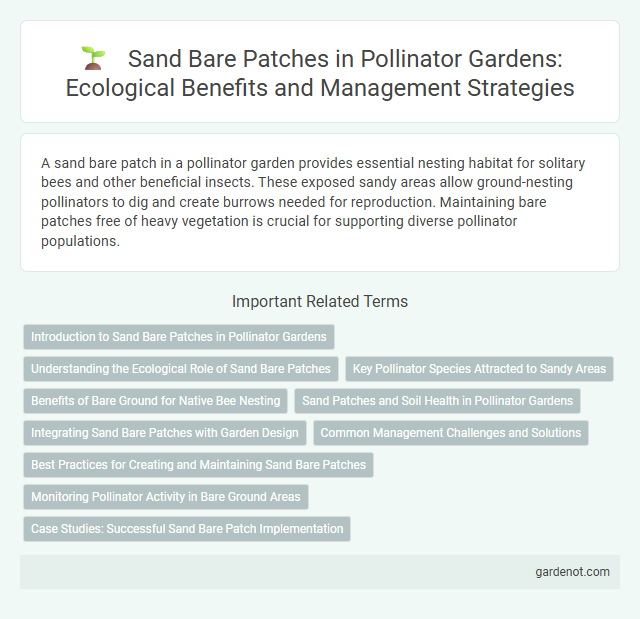A sand bare patch in a pollinator garden provides essential nesting habitat for solitary bees and other beneficial insects. These exposed sandy areas allow ground-nesting pollinators to dig and create burrows needed for reproduction. Maintaining bare patches free of heavy vegetation is crucial for supporting diverse pollinator populations.
Introduction to Sand Bare Patches in Pollinator Gardens
Sand bare patches in pollinator gardens provide essential nesting habitats for solitary bees and ground-nesting insects. These open, sandy areas mimic natural conditions, allowing pollinators to dig burrows and lay eggs safely. Maintaining well-drained, undisturbed sand bare patches enhances biodiversity and supports healthy pollinator populations.
Understanding the Ecological Role of Sand Bare Patches
Sand bare patches serve as crucial microhabitats within pollinator gardens, providing nesting and basking sites for ground-nesting bees and other beneficial insects. These patches enhance biodiversity by supporting species that rely on exposed sandy soils for reproduction and thermoregulation. Preserving and incorporating sand bare patches into garden design fosters a healthy pollinator ecosystem and promotes natural pest control.
Key Pollinator Species Attracted to Sandy Areas
Sandy bare patches in pollinator gardens attract key species such as mining bees (Andrena spp.), which prefer loose, well-drained soil for nesting. Other notable pollinators include sweat bees (Halictidae family) and digger bees (Anthophorini tribe), both of which utilize sandy substrates for burrowing. These habitats are critical for supporting solitary bee populations essential for ecosystem pollination services.
Benefits of Bare Ground for Native Bee Nesting
Bare ground patches provide essential nesting habitats for many native bee species, promoting biodiversity and healthy pollinator populations. These exposed soil areas enable ground-nesting bees to excavate tunnels where they lay eggs and protect their larvae. Supporting bare ground habitats in pollinator gardens enhances native bee reproduction and ecosystem resilience.
Sand Patches and Soil Health in Pollinator Gardens
Sand patches in pollinator gardens create essential habitats for ground-nesting bees, promoting biodiversity and supporting pollination. Maintaining well-drained, loose sand soil enhances aeration and prevents waterlogging, which is crucial for the health of solitary bee species. Proper soil health management in these sandy areas ensures a balanced ecosystem that sustains robust pollinator populations.
Integrating Sand Bare Patches with Garden Design
Integrating sand bare patches into pollinator garden design enhances habitat diversity by providing essential nesting sites for solitary bees and other ground-nesting pollinators. Strategically placing these patches in sunny, well-drained areas surrounded by native flowering plants increases pollinator visitation and supports biodiversity. Incorporating sand bare patches not only promotes ecological balance but also contributes to the garden's functional and visual appeal.
Common Management Challenges and Solutions
Sand bare patches in pollinator gardens often result from soil erosion, poor water retention, or overexposure to sunlight, which hinder plant growth and reduce habitat quality for pollinators. Managing these patches involves incorporating organic mulch, establishing drought-tolerant native plants, and implementing erosion control measures such as installing ground covers or using biodegradable mats. Regular soil testing and amending with compost or biochar improve soil structure and nutrient availability, effectively restoring fertility and supporting diverse pollinator species.
Best Practices for Creating and Maintaining Sand Bare Patches
Creating sand bare patches involves clearing vegetation to expose sand, providing essential nesting sites for solitary bees and ground-nesting pollinators. Ensure the patches receive full sunlight, are free from mulch and heavy organic debris, and maintain gentle slopes for easy access and drainage. Regularly inspect and clear invasive plants to preserve open ground, enhancing pollinator habitat and biodiversity.
Monitoring Pollinator Activity in Bare Ground Areas
Monitoring pollinator activity in sand bare patches provides critical data on nesting behaviors and species diversity among ground-nesting bees. Regular observation and documentation of visitation rates and nest construction help assess habitat suitability and pollination efficiency in these microhabitats. Employing time-lapse photography and soil disturbance evaluations enhances the understanding of seasonal patterns and environmental impacts on pollinator populations in bare ground areas.
Case Studies: Successful Sand Bare Patch Implementation
Case studies demonstrate that successful sand bare patch implementation in pollinator gardens significantly enhances habitat diversity, supporting ground-nesting bees like Andrena and Halictidae species. Research from the Xerces Society highlights increased nesting activity and pollination rates where bare sandy soil patches are maintained, leading to improved local biodiversity and crop yields. Effective management includes periodic disturbance to prevent vegetation overgrowth, ensuring optimal nesting conditions for target pollinator populations.
Sand bare patch Infographic

 gardenot.com
gardenot.com